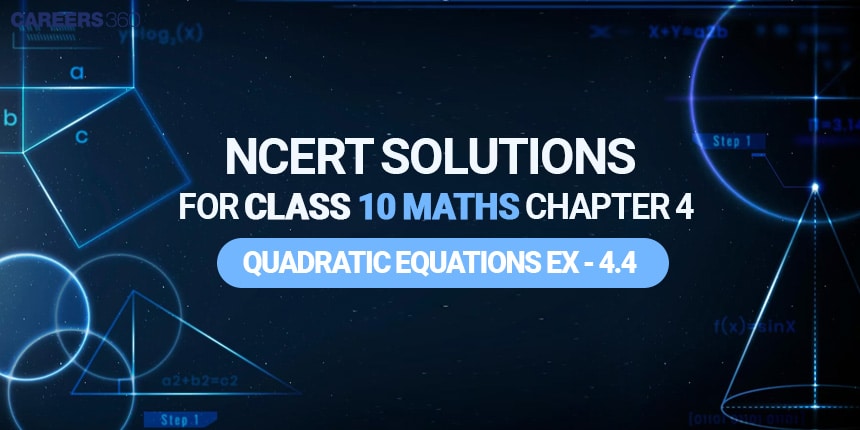Aakash Repeater Courses
Take Aakash iACST and get instant scholarship on coaching programs.
The exercise examines quadratic equation analysis by using the discriminant approach. We determine the root nature of quadratic equations through the discriminant because it reveals two real, distinct roots or one real root or no real roots. We need this knowledge to solve equations that define real-world models because it enables us to find correct dimensions and check practical possibilities in real situations. The exercise demonstrates why knowing the discriminant allows us to understand solution characteristics before requiring complete solution computation.
Don't Miss: Best Courses after 10th | Competitive Exams after 10th
Don't Miss: JEE Main & NEET 2026 Scholarship Test (Class 10): Narayana | Aakash

Students can enhance their ability to detect the root characteristics using discriminant analysis through the NCERT Solutions available. Learners enhance their understanding of the nature of discriminant analysis roots and applications by completing exercises from the NCERT Books. Among the solutions provided is structured content that builds essential problem-solving and analytical thinking abilities, which supports future advanced mathematical progression.
Answer:
To check whether real roots exist, we first find the discriminant.
If D > 0, then the roots are distinct and real.
If D < 0, then no real roots.
If D = 0, then there exist two equal real roots.
Given the quadratic equation,
So,
Therefore, discriminant
Thus, D < 0 (negative)
Hence, there are no real roots possible for the given equation.
Answer:
To check whether real roots exist, we first find the discriminant.
If D > 0, then the roots are distinct and real.
If D < 0, then no real roots.
If D = 0, then there exist two equal real roots.
Given the quadratic equation,
Here, the value of the discriminant = 0, which implies that roots exist and the roots are equal.
The roots are given by the formula
So the roots are
Answer:
To check whether real roots exist, we first find the discriminant.
If D > 0, then the roots are distinct and real.
If D < 0, then no real roots.
If D = 0, then there exist two equal real roots.
Given the quadratic equation,
The discriminant > 0. Therefore, the given quadratic equation has two distinct real roots
The roots are given by the formula
So the roots are
Answer:
For two equal roots for the quadratic equation:
Given equation:
Comparing and getting the values of a,b, and c.
The value of
Or,
Q2 (ii) Find the values of k for each of the following quadratic equations so that they have two equal roots
Answer:
For two equal roots for the quadratic equation:
Given equation:
Can be written as:
Comparing and getting the values of a,b, and c.
The value of
But
Hence, the only value of
Answer:
Let the breadth of the mango grove be $b$.
Then, according to the question, the length of the mango grove will be
Therefore, the area will be:
Which will be equal to
Comparing to get the values of
Finding the discriminant value:
Here,
Therefore, the equation will have real roots.
And hence finding the dimensions:
We know that a negative value is not possible; therefore, the value of the breadth ofthe mango grove will be 20m.
And the length of the mango grove will be:
Answer:
Let the age of one friend be
Now, 4 years ago, their ages were
According to the question, the product of their ages in years was 48.
Therefore (x-4)(20-x-4) = 48
Now, comparing to get the values of
Discriminant value
As
Therefore, there are no real roots possible for this given equation, and hence, this situation is not possible.
Answer:
Let us assume the length and breadth of the park be
Then, the perimeter will be
Now, the area of the park is:
Given : Area = 400 m2
So,
Comparing to get the values of a, b and c.
The value of the discriminant
As
Therefore, this equation will have two equal roots.
And hence the roots will be:
Therefore, the length of the park,
Also Read-
Take Aakash iACST and get instant scholarship on coaching programs.
1. Discriminant Analysis: The discriminant (D = b² - 4ac) enables understanding while helping users compute its value for determining the nature of the quadratic equation roots.
2. Nature of Roots: The nature of roots can be determined by examining the value of the discriminant to find real distinct roots or real equal roots, or non-real roots.
3. Application to Real-Life Problems: Discriminant evaluation helps solve practical problems through the development of quadratic equations to check solution feasibility between real-world applications and mathematical analysis.
4. Parameter Determination: The determination of specific parameter values leads to quadratic equations that share equal roots.
5. Graphical Interpretation: The Discriminant reveals its relationship with quadratic equation graphs, which demonstrates its effect on x-axis parabola intersections.
Check Out-
Students must check the NCERT solutions for class 10 of the Mathematics and Science Subjects.
Students must check the NCERT Exemplar solutions for class 10 of the Mathematics and Science Subjects.
Nature of root tell us that whether the roots are equal or distinct and they also tell us roots are real or non real
Discriminant of quadratic equation is (b2 - 4ac ) and we substitute the value of b, c, a from ax2+ bx + c = 0
There are three ways to categorise discriminant: 9I) two distinct real roots, if (b2 - 4ac)> 0; (ii) two equal real roots, if b2 - 4ac)= 0; (iii) no real roots, if (b2 - 4ac)=0
Non-real roots are imaginary roots because discriminant is negative that is why they are unsolvable under root.
There are mainly 3 questions that are solved before the Class 10 Maths chapter 4 exercise 4.3, which are based on the nature of the root
There are five questions in exercise 4.3, Class 10 Maths. Question one has three subparts and question two has two subparts.
There are three types of questions in exercise 4.3 Class 10 Maths question one has direct subparts to find the nature of the root of the quadratic equation then in question two we have given nature of root and we have to find the missing variable in the quadratic equation .question three, four and five are word problem which is based on the real-world application.
Exam Date:22 July,2025 - 29 July,2025
Exam Date:22 July,2025 - 28 July,2025
Hello
Since you are a domicile of Karnataka and have studied under the Karnataka State Board for 11th and 12th , you are eligible for Karnataka State Quota for admission to various colleges in the state.
1. KCET (Karnataka Common Entrance Test): You must appear for the KCET exam, which is required for admission to undergraduate professional courses like engineering, medical, and other streams. Your exam score and rank will determine your eligibility for counseling.
2. Minority Income under 5 Lakh : If you are from a minority community and your family's income is below 5 lakh, you may be eligible for fee concessions or other benefits depending on the specific institution. Some colleges offer reservations or other advantages for students in this category.
3. Counseling and Seat Allocation:
After the KCET exam, you will need to participate in online counseling.
You need to select your preferred colleges and courses.
Seat allocation will be based on your rank , the availability of seats in your chosen colleges and your preferences.
4. Required Documents :
Domicile Certificate (proof that you are a resident of Karnataka).
Income Certificate (for minority category benefits).
Marksheets (11th and 12th from the Karnataka State Board).
KCET Admit Card and Scorecard.
This process will allow you to secure a seat based on your KCET performance and your category .
check link for more details
https://medicine.careers360.com/neet-college-predictor
Hope this helps you .
Hello Aspirant, Hope your doing great, your question was incomplete and regarding what exam your asking.
Yes, scoring above 80% in ICSE Class 10 exams typically meets the requirements to get into the Commerce stream in Class 11th under the CBSE board . Admission criteria can vary between schools, so it is advisable to check the specific requirements of the intended CBSE school. Generally, a good academic record with a score above 80% in ICSE 10th result is considered strong for such transitions.
hello Zaid,
Yes, you can apply for 12th grade as a private candidate .You will need to follow the registration process and fulfill the eligibility criteria set by CBSE for private candidates.If you haven't given the 11th grade exam ,you would be able to appear for the 12th exam directly without having passed 11th grade. you will need to give certain tests in the school you are getting addmission to prove your eligibilty.
best of luck!
According to cbse norms candidates who have completed class 10th, class 11th, have a gap year or have failed class 12th can appear for admission in 12th class.for admission in cbse board you need to clear your 11th class first and you must have studied from CBSE board or any other recognized and equivalent board/school.
You are not eligible for cbse board but you can still do 12th from nios which allow candidates to take admission in 12th class as a private student without completing 11th.

Take Aakash iACST and get instant scholarship on coaching programs.

This ebook serves as a valuable study guide for NEET 2025 exam.

This e-book offers NEET PYQ and serves as an indispensable NEET study material.

As per latest syllabus. Physics formulas, equations, & laws of class 11 & 12th chapters
As per latest syllabus. Chemistry formulas, equations, & laws of class 11 & 12th chapters
As per latest 2024 syllabus. Study 40% syllabus and score upto 100% marks in JEE